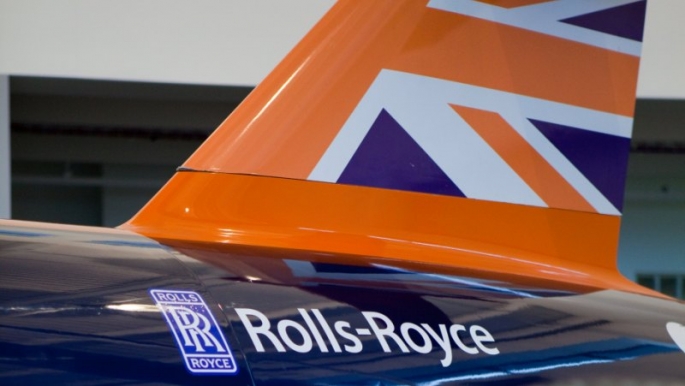
• Rolls-Royce jet engine powering BLOODHOUND SSC
• First land speed record sponsored by Rolls-Royce
• Rolls-Royce ambassadors helping to inspire future generation of engineers
Rolls-Royce PLC today announced support for The BLOODHOUND Project, an international education initiative focused on a 1,000 mph World Land Speed Record attempt. A Rolls-Royce EJ200 jet engine will be used in conjunction with a custom designed hybrid rocket to propel the car to over 1,000 mph (1,600 kmh or Mach 1.4). Rolls-Royce will also provide financial and technical support for the project.
Announcing the partnership at an event for staff and BLOODHOUND team members at their Filton site, Bristol, Rolls-Royce Director of Engineering and Technology, Colin Smith, called for the UK to do more to inspire young people about science, technology, engineering and mathematics.
 Colin Smith CBE, Director of Engineering and Technology at Rolls-Royce, said: “Cutting edge engineering keeps Rolls-Royce, and the UK, at the forefront of global business. We understand the fundamental importance of inspiring young people about STEM and know that more needs to be done. Sponsoring BLOODHOUND gives us an opportunity to showcase world-class British engineering and invest in our future.”
Colin Smith CBE, Director of Engineering and Technology at Rolls-Royce, said: “Cutting edge engineering keeps Rolls-Royce, and the UK, at the forefront of global business. We understand the fundamental importance of inspiring young people about STEM and know that more needs to be done. Sponsoring BLOODHOUND gives us an opportunity to showcase world-class British engineering and invest in our future.”
Richard Noble OBE, BLOODHOUND Project Director said: “Rolls-Royce’s support of the Programme is invaluable, their highly motivated ambassadors will help us reach many more schools and youth groups across the country. Their experience of working within a first class aerospace company makes them perfect role models for aspiring engineers”.
The Group’s iconic logo will now be displayed on the engine cowlings of BLOODHOUND’s Rolls-Royce built EJ200 jet engine; which, in its normal role, generates 20,000lb 90 kN thrust to power the twin-engined Eurofighter Typhoon combat aircraft.
Rolls-Royce has a long and distinguished association with speed record breaking on land, sea and in the air. In the 1930’s its ‘Type R’ engine powered Sir Malcolm Campbell’s Bluebird cars and boats, Capt. George Eyston’s Thunderbolt car, Sir Henry Segrave’s Miss England II boat and the Supermarine S6B sea plane of Flt Lt John Boothman, outright winner of the Schnieder Trophy in 1931. Experience gained on the ‘R’ in the use of improved materials, supercharger technology and enhanced fuels was later used to great effect in the Merlin which saw action in the Spitfire, Hurricane, Lancaster and Mustang aircraft of World War Two.
 More recently, in 1983, Richard Noble, now BLOODHOUND’s Project Director, used a Rolls-Royce Avon 302 1983 in Thrust 2 to set a record of 633.047 mph (1,019.47 km h) while two Spey 202 turbofan engines, as used in a McDonald Douglas F4 Phantom, enabled Wing Commander Andy Green to become the first, and so far only, person to break the sound barrier on land in Thrust SSC, which set the current record of 763.035 mph (1,227.986 km h) in 1997. The company did not officially sanction or endorse any of these activities, however.
More recently, in 1983, Richard Noble, now BLOODHOUND’s Project Director, used a Rolls-Royce Avon 302 1983 in Thrust 2 to set a record of 633.047 mph (1,019.47 km h) while two Spey 202 turbofan engines, as used in a McDonald Douglas F4 Phantom, enabled Wing Commander Andy Green to become the first, and so far only, person to break the sound barrier on land in Thrust SSC, which set the current record of 763.035 mph (1,227.986 km h) in 1997. The company did not officially sanction or endorse any of these activities, however.
In 2008 Rolls-Royce became an early adopter of the project, formally deciding to provide the programme with essential engine support which in turn enabled the Ministry of Defence to loan three redundant early development EJ200 jet engines once the Eurofighter Typhoon flight development programme had been completed.
The power systems company lent its expertise to the complex aerodynamics programme, the installation of the EJ200 and the optimisation of its air intake; a major challenge in its own right given the cars unique performance and its vast speed range.
Just as significant is the company’s support for BLOODHOUND’s global education programme, which aims to inspire the next generation of scientists, engineers and mathematicians in the 219 countries and territories where the Project is followed.
56 trained Rolls-Royce BLOODHOUND ambassadors will assist school teachers all over the country deliver exciting BLOODHOUND themed lessons. The ambassadors will play a key role in helping young people to make positive career choices by giving real life context to their science, technology, engineering and mathematics (STEM) subjects. Currently 5,442 UK primary and secondary schools have signed up to join the BLOODHOUND Education Programme, equating to roughly 2.5 million pupils.
- Ends -
(pictures: Stefan Marjoram)

For more information, contact Jules Tipler [email protected]
Notes to Editors
- The world land speed record of 763 mph is held by Thrust SSC, a UK team lead by BLOODHOUND’s Project Director Richard Noble and driven by Andy Green.
- Components for BLOODHOUND SSC are being manufactured by specialists across the UK and delivered to the BLOODHOUND Technical Centre in Bristol for assembly throughout 2013.
- UK runway testing (up to 200 mph) will get underway early 2014 before the team decamp to the Hakskeen Pan, South Africa to begin high speed testing.
- The BLOODHOUND team scoured the globe to find the perfect desert to run the car on, it needed to be at least 12 miles long, two miles wide and perfectly flat. The Hakskeen Pan, Northern Cape, South Africa was selected.
- At full speed BLOODHOUND SSC will cover a mile in 3.6 seconds, that’s 4.5 football pitches laid end to end per second.
- BLOODHOUND has three power plants, a Rolls-Royce EJ200 jet from a Eurofighter Typhoon, a custom designed hybrid rocket and a 750 bhp Cosworth F1 engine that drives the rocket oxidiser pump. Between them they generate 135,000 equivalent hp, equal to 180 F1 cars.



